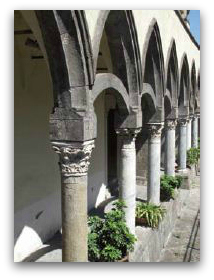
- Outside, detail
The space overlooking Castel Nuovo was in Medieval times named Correge because of the torneos and jousting that took place there. In the 14th century, the area boasted numerous aristocratic palaces and public buildings of which the only surviving one is the Church of the Incoronata. Founded by Joanna of Anjou for her coronation in 1352 and called the "crown of thorns" of Jesus, by virtue of the relique donated by the queen which came from the Sainte Chapelle in Paris - in fact, its original name was Thorn-Crown.
The works ordered by Charles V for the new bastions of Castel Nuovo resulted in a raising of the roadway and the church was three metres underground. When it was reopened in the 18th century, it was afterwards incorporeted in another building. During the first thirty years of the 20th century, restoration work began to take back the church to its original appearance and frescoes of Roberto d'Oderisio were found and restored. The Gorthic-style church has an irregular plan with two aisles and a polygonal apse; the central nave is flanked on the left by a minor aisle and on the right by an external portico.
So the church was probably built on a pre-existing building of the time of Robert of Anjou, the Royal Tribune (1309-43), to which the main aisle and the external portico belong, while the minor aisle must have been added when the church was built (1352). The Incoronata was entirely frescoed; some of the picture cycles were taken down from the walls in the Seventies, restored and returned to the church.
The cycle painted by Roberto d'Oderisio, a Giotto's Neapolitan pupil is very important; it shows Bible stories (on the walls), the Sacraments and the Triumph of the Church (ceiling); in the latter, Robert of Anjou and his son Charles of Calabria appear. The altar and the communion-rail in polychrome marble and hard stones are testimony to the Baroque restoration in the 18th century.
In the minor aisle there are 15th-century frescoes of Stories of Ladislao, the work of a painter from the Marche. Of particular importance is the 14th-century main white marble portal, and on the architrave the Thorn-Crown held up by two angels is carved.